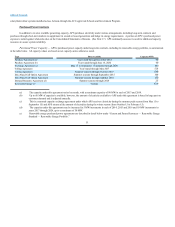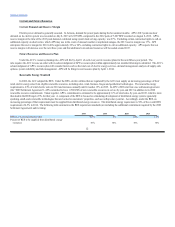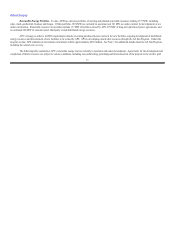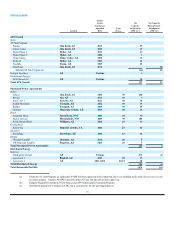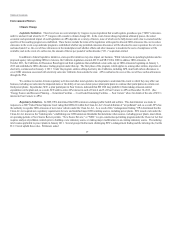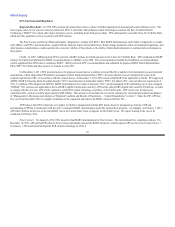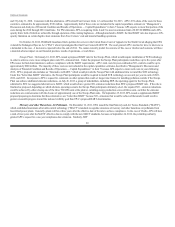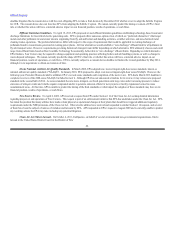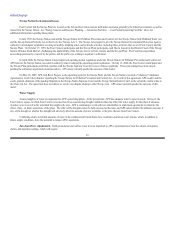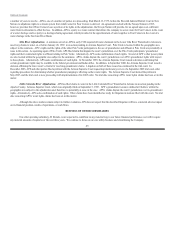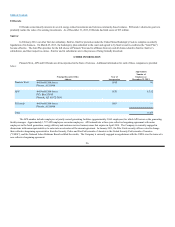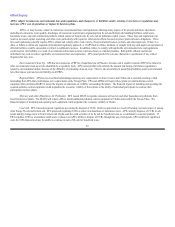APS 2013 Annual Report Download - page 24
Download and view the complete annual report
Please find page 24 of the 2013 APS annual report below. You can navigate through the pages in the report by either clicking on the pages listed below, or by using the keyword search tool below to find specific information within the annual report.
Table of Contents
will have until April 16, 2016 to comply with MATS at the Navajo Plant, as a result of a one-year extension granted by EPA and the Navajo Nation EPA on
January 27, 2014.
The MATS will require APS to install additional pollution control equipment. APS has installed certain of the equipment necessary to meet the
anticipated standards. APS estimates that the cost for the remaining equipment necessary to meet these standards is approximately $120 million for Cholla
Units 2 and 3. These costs are not included in the capital expenditure estimates described in “Management’s Discussion and Analysis of Financial Condition
and Results of Operations — Capital Expenditures” in Item 7. No additional equipment is needed for Four Corners Units 4 and 5 to comply with these
rules. SRP, the operating agent for the Navajo Plant, is still evaluating compliance options under the rules.
Cooling Water Intake Structures. EPA issued its proposed cooling water intake structures rule on April 20, 2011, which provides national
standards applicable to certain cooling water intake structures at existing power plants and other facilities pursuant to Section 316(b) of the Clean Water Act.
The proposed standards are intended to protect fish and other aquatic organisms by minimizing impingement mortality (the capture of aquatic wildlife on
intake structures or against screens) and entrainment mortality (the capture of fish or shellfish in water flow entering and passing through intake structures).
To minimize impingement mortality, the proposed rule would require facilities, such as Four Corners and the Navajo Plant, to either demonstrate that
impingement mortality at their cooling water intakes does not exceed a specified rate or reduce the flow at those structures to less than a specified velocity, and
to take certain protective measures with respect to impinged fish. To minimize entrainment mortality, the proposed rule would also require these facilities to
conduct a “structured site-specific analysis” to determine what site-specific controls, if any, should be required. Additional studies and a peer review process
will also be required at these facilities.
As proposed, existing facilities subject to the rule would have to comply with the impingement mortality requirements as soon as possible, but in no
event later than eight years after the effective date of the rule, and would have to comply with the entrainment requirements as soon as possible under a
schedule of compliance established by the permitting authority. APS is performing analyses to determine the costs of compliance with the proposed rule. EPA
will issue the final standards upon completion of its ongoing ESA consultations with the U.S. Fish and Wildlife Service and National Marine Fisheries
Service and is working to finalize the standards by April 2014.
Coal Combustion Waste. On June 21, 2010, EPA released its proposed regulations governing the handling and disposal of coal combustion
residuals (“CCRs”), such as fly ash and bottom ash. APS currently disposes of CCRs in ash ponds and dry storage areas at Cholla and Four Corners, and
also sells a portion of its fly ash for beneficial reuse as a constituent in concrete production. EPA proposes regulating CCRs as either non-hazardous waste
under Subtitle D of the Resource Conservation and Recovery Act (“RCRA”) or hazardous waste under Subtitle C of RCRA and requested comments on three
different alternatives. The hazardous waste proposal would phase out the use of ash ponds for disposal of CCRs. The other two proposals would regulate
CCRs as non-hazardous waste and impose performance standards for ash disposal. One of these proposals would require retrofitting or closure of currently
unlined ash ponds, while the other proposal would not require the installation of liners or pond closures. EPA has not yet indicated a preference for any of the
alternatives.
In April 2012, a coalition of environmental groups filed suit to compel EPA to finalize its proposed CCR rule. Soon thereafter, coal ash recyclers
filed similar lawsuits against EPA, which were consolidated with the environmental groups’ lawsuits. On January 29, 2014, the parties in the CCR
21


